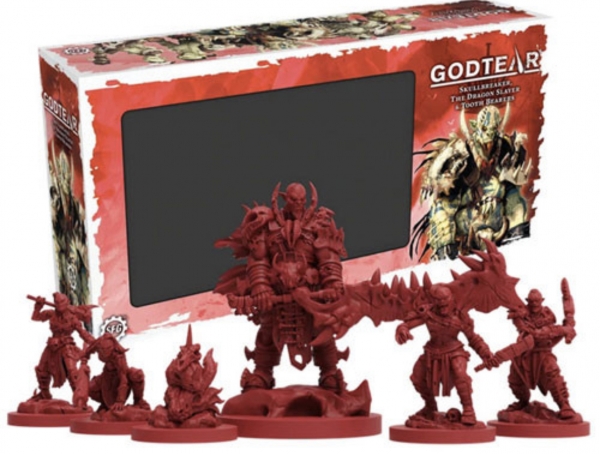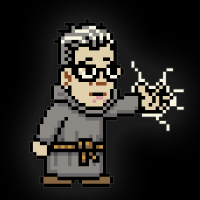One of the best games you aren't playing.
Look, chances are you slept on Steamforged Games’ Godtearjust like I had but I’m here to tell you that we made a mistake. I know that there’s some bad blood from slighted Guildballplayers out there and god knows there’s only an umptyjilliontwo player skirmish games out there now. Yeah, it’s another one of those Kickstarter games laden with bubblegum machine figures and SKUs. And I get it, Godtear came out as the same time as COVID-19 so it wasn’t like you could go check it out at the FLGS, let alone participate in developing any kind of community around it. I’ll also admit that the way this fairly expensive game is packaged with two starter sets (neither of which give you a complete Godtear experience on their own) and then a bunch of expansion packs makes me stressed out and nauseous. Even the title is super cringe and off-putting, more fitting for a Type O Negative-worshipping industrial metal outfit circa 1999 than for a tabletop game today.
Despite having all of this baggage working against it this head-to-head skirmish game, in which each player picks three champions and their followers to do battle over the titular objective points, is one of the best games in its class. It represents a point where the exchange of ideas between the board gaming world and the miniatures gaming world may have reached an apotheosis. It’s a brilliant piece of design work that almost feels like a sports game at times, but it also feels more like proper miniatures battle than many other games in its class. More significantly, it’s almost like the design brief here was to deliberately avoid, mitigate, or eliminate the issues, barriers, and hassles that plague miniatures games. It’s supremely easy to set up and knock out a 60–90-minute game and between experienced players you are likely to come out of it feeling like it was a tooth-and-nail fight rather than a game won in the alpha strike with two hours of resolution following.
The format is simple and doesn’t require any kind of list building, codices, or anything like that. You just choose three Champions that you like, and each come with 1 to 4 followers. There are four types of champions – Slayers that excel at killing other Champions, Shapers that get a bonus for claiming objective tiles, Malestroms that especially like to murder followers, and Guardians that want to make sure that their warband’s banner is out on the field. You can mix and match all you want and there’s no lore or canon to restrict anything. They are even color-coded so it’s not necessary to paint them to tell them apart.
With your warband on the field, gameplay proceeds in an unexpected way. The first phase of each of the game’s five rounds is Plotting. During this phase, each player activates each Champion and follower group and does two actions. Part of the activation might include skills printed on each unit’s card. This is the time to maneuver, get into position, claim objectives, put Boons and Blights (buffs and debuffs) out, and set up attacks. Because the second phase is the Clash, and the meter shifts to I-go-you-go with each player activating one unit at a time. Here’s the kicker. Those unit cards? They flip over and have differentskills for the Clash. It’s a really cool structure and it creates a lot of strategic possibilities, combo opportunities, and unexpected depth while also not burdening the game with excessive rules or card text. Each Champion also has a card with an ULTIMATE skill that is a one-shot deal, and they are usually quite impactful
Resolutions are the classic Warhammer-influenced process of rolling to hit and rolling to wound with an armor stat soaking damage. Most followers take one hit and are off the board until their unit makes a Rally action and reinforces. Champions have several hit points and are never eliminated, just KO’d until they do a Rally themselves. I love that no unit is ever just out of the game- I think we’ve all been crestfallen to see a $100 model we’ve painted our guts out on get wiped out in turn 1. That can’t happen here.
 (Photo stolen from Charlie Theel)
(Photo stolen from Charlie Theel)
Now, since total destruction isn’t a thing, this is a points-based design and that’s where it starts to feel more like sports than war. Placing a unit’s banner on an objective tile lets you move the round marker one space toward your side of a tracker as does killing a follower. Knocking out a Champion is a 4 space move in your favor. And there are end-of-round bonuses to be earned for keeping your Banners out there to the end of the round, provided enemy Champions didn’t go and knock them down. The score tracker is a differential, so you want to have the score marker on your side at the end of the round and if you do, you win the Victory Points for the round. Here’s another neat trick this game pulls – round 1 is worth only a point, round 2 is worth 2. Round 3 is worth- you guessed it- 3 points. What about round 4 and 5? Nope, you’re wrong. The point values go down. That third round is the one you really, really want to win because it’s the height of the battle, the point around which the rest of the game revolves You see, the goal is to win 5 points. I’ve only had like two games go to round 5 with most culminating in rounds 3 and 4. This game respects your time and doesn’t force you to play out a losing battle.
Godtear is scenario based but please don’t let that scare you away. The setups are extremely simple- just placing a couple of Godtear tiles on a hex map. Each of them has a couple of parameters that impact how it all plays out. Some have the player losing the previous round moving, removing, or placing Godtears. Others have limits on the scoring ladder. And the orientation of the Godtears actually has a pretty profound effect on how it all plays out- whether it turns into a more mobile battle, a stand-up fight in the center for a more lane-based conflict with units sort of channeled into one-on-one combat, or one in which either player might decide that there is more profitin just killing the other side rather than fussing with banners at all.
This is a dynamic game because of all of the above, but the Champions and Followers really elevate it all into something extraordinary. They are all good, they are all balanced. It’s true that some are more situationally effective and some matchups between specific units are tremendously lopsided, but that is all part of what makes this game so compelling. The skills have a wide range of effects from straight combat to buffing or debuffing units. Some have area attacks, some target multiple models, other do weirder and wilder things. Finding synergy between your three selecting Champions and Followers is never less than exciting and working out creative ways to leverage advantages lends a lot of depth. But you are still just looking at six unit cards per phase with virtually zero need to reference the rulebook once you’ve gone through the learning curve.
The rules are decently written but could clearly have used some refinement- the first couple of games are liable to be somewhat shaky, there are a few details that seem counter-intuitive if you are coming in from similar games – like how only one follower model activates to use a skill, not their whole unit or even all of them in a hex. Expect a couple of “hang on, we did that wrong” beats but bear with them and you’ll find that this is a supremely smooth-playing, fascinating game that emphasizes play over rules arguments or excessive process.

Now, I don’t usually do “buyer’s guide” kinds of commentary, But I think that it is warranted for this game because the way it is marketed is a disaster. If your interest is piqued, I regret to inform you that the starter sets do not give you adequate materials to play the game. If you buy both starter sets, you are still coming up short. Each starter includes two Champion/Follower sets, a board, dice, and a couple of punchboards of tokens. With them, you can play matches with one Champion each. This sucks and gives a terrible first impression of the design. My son and I played two turns of the suggested one-on-one starter game and reset to play with three Champions each as it should be. So the initial outlay here really needs to be to either pick up both starters (which will give you one of each color Champion) and then two of the individually sold Champion boxes. I don’t think it really matters which, just pick the ones you like. From there, my suggestion is to do what I do and trawl eBay for lowball offers around $20 for the others that you want.
Despite it being one of those expensive Kickstarter mill games with tons of plastic and a pile of SKU and regardless of any baggage or misgivings, Godtear is the biggest surprise in games I’ve had for a while. I totally wrote it off and would have had zero interest in it whatsoever if it weren’t for articles and comments written by folks whose opinions I value, like CharileTheel, Raf Cordero, and Vysetron. It’s a supremely solid and lively design that does everything I want miniatures games to do but in a board game format, and it’s doing this better than any other game has to date.
 Games
Games How to resolve AdBlock issue?
How to resolve AdBlock issue? 


























